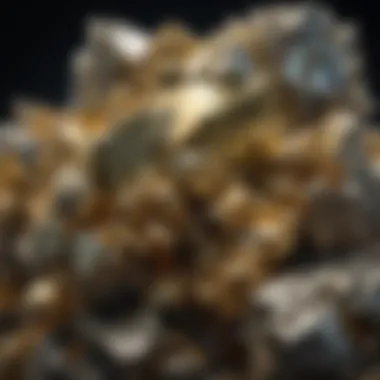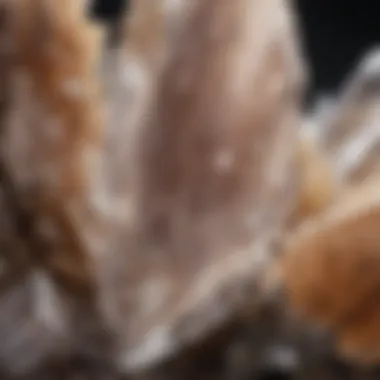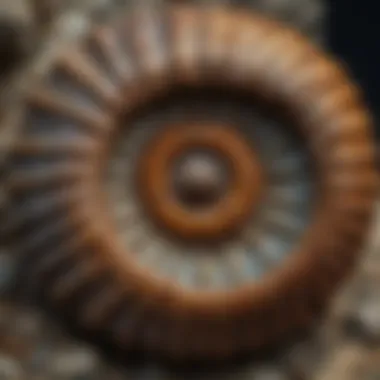Unlocking the Secrets: A Comprehensive Guide to Identifying Rocks, Minerals, and Crystals


Rock and Fossil Identification
When it comes to identifying rocks, minerals, and crystals, it is essential to explore the various types and characteristics that distinguish one specimen from another. Rocks can be categorized into sedimentary, igneous, and metamorphic types, each with unique features that aid in their identification. Fossils, on the other hand, offer a glimpse into the Earth's history, showcasing ancient organisms preserved in rock formations. Key characteristics to look for when identifying rocks include color, texture, luster, cleavage, and hardness. Similarly, fossil identification involves examining details like shape, size, patterns, and any imprints left behind.
To aid in the identification process, collectors can utilize a variety of tools such as magnifying glasses, geology hammers, streak plates, and loupes. These tools help enthusiasts observe minute details and determine the composition of a specimen, leading to accurate identification and classification.
Collecting Tips and Techniques
For avid collectors looking to expand their collections, adopting best practices for collecting rocks, minerals, and crystals is paramount. It is crucial to research prime collecting sites where unique specimens can be found, whether it be near geological formations, beaches, or quarries. Safety should always be a top priority when extracting specimens, with the use of safety goggles, gloves, and appropriate tools to prevent accidents.
When collecting specimens, it is important to exercise caution and respect for the environment, ensuring that sites are left undisturbed and pristine for future enthusiasts. By following ethical guidelines and regulations, collectors can contribute to the preservation of geological treasures for generations to come.
Preservation and Display
Once specimens have been collected and identified, proper preservation techniques are vital to maintain their integrity and quality. Techniques such as sealing in airtight containers, using desiccants to absorb moisture, and protecting from direct sunlight can help prolong the lifespan of rocks, minerals, and crystals.
When it comes to displaying collections, creativity knows no bounds. Enthusiasts can opt for various methods such as mounting specimens on stands, arranging in shadow boxes, or creating themed displays based on geological eras or colors. By showcasing collections thoughtfully, collectors can share their passion for geology with fellow enthusiasts and inspire curiosity in others.
Geological Insights
Delving into the geological aspects of rocks, minerals, and crystals provides a deeper understanding of our planet's history and processes. Geological formations offer insights into the Earth's transformative forces, showcasing the effects of volcanism, erosion, and tectonic activity over millions of years.
The historical significance of rocks and fossils cannot be understated, with each specimen holding a story of the prehistoric world. Notable discoveries in the field contribute to our knowledge of ancient environments, ecosystems, and evolutionary processes, enriching our understanding of the natural world.
Exploring the interdisciplinary nature of geology and paleontology unveils a world of wonder and discovery, where enthusiasts can witness the beauty and complexity of Earth's geological riches firsthand.
Introduction


Rocks, minerals, and crystals hold a timeless allure, fascinating both amateur collectors and seasoned enthusiasts. This comprehensive guide aims to demystify the intricate world of geological specimens, shedding light on their hidden complexities and unique characteristics. By delving into the rich tapestry of rocks, minerals, and crystals, readers embark on a journey of exploration and discovery, uncovering the hidden treasures that lie beneath the Earth's surface.
Overview of Rocks, Minerals, and Crystals
Diving into the realm of geology, one encounters a diverse array of rocks, minerals, and crystals, each with its distinct features and properties. Understanding these foundational elements is key to grasping the essence of the Earth's geological composition. Rocks, formed through various geological processes, encapsulate the history of our planet, providing clues to its past. Minerals, the building blocks of rocks, exhibit a kaleidoscope of colors and structures, each bearing unique chemical compositions. Crystals, renowned for their symmetry and optical properties, capture the imagination with their exquisite beauty and metaphysical allure.
In this section, we delve into the fundamental characteristics of rocks, minerals, and crystals, offering a glimpse into their mesmerizing world. From the formation processes that shape rocks to the spectroscopic analysis of minerals, we unravel the mysteries that define these intriguing specimens. By exploring the overview of rocks, minerals, and crystals, readers gain a profound appreciation for the geological wonders that adorn our planet, sparking a passion for exploration and discovery.
Characteristics of Rocks
In this article, understanding the Characteristics of Rocks holds paramount importance for rock, mineral, and crystal enthusiasts. Delving into the textures, compositions, colors, and streaks of these specimens provides a foundational knowledge base for collectors. By grasping the unique features and properties of different rock types, enthusiasts can better identify, appreciate, and differentiate one specimen from another. The Characteristics of Rocks section aims to equip readers with the necessary skills to discern the myriad subtleties that make each rock, mineral, or crystal distinct.
Texture and Composition
Identifying Mineral Composition
One key aspect within the Texture and Composition category is Identifying Mineral Composition, which serves as a cornerstone for rock identification. By examining the specific minerals present in a rock, collectors can determine its geological origins and unique properties. Understanding mineral composition aids collectors in categorizing rocks and minerals accurately, enabling them to expand their knowledge base and identification skills. The detailed analysis of mineral composition enhances the overall comprehension of rock characteristics, leading to more informed collecting experiences.
Recognizing Different Textures
Another crucial element in the Texture and Composition realm is Recognizing Different Textures. Texture plays a significant role in identifying rocks and minerals, as it provides insights into the formation process, crystalline structure, and overall appearance of specimens. By recognizing diverse textures, collectors can uncover essential clues about a rock's history, environmental conditions, and physical properties. Understanding texture variations helps enthusiasts distinguish between different rock types, enhancing their ability to discern subtle differences and make informed decisions during collection expeditions.
Color and Streak
Understanding Color Variations
In the Color and Streak segment, Understanding Color Variations emerges as a pivotal aspect for collectors. Colors in rocks and minerals result from various mineral compositions, impurities, and environmental factors, reflecting the geological processes that shaped each specimen. By understanding color variations, enthusiasts can identify diagnostic hues that aid in rock classification and mineral recognition. Exploring the diverse range of colors enhances collectors' visual acuity and sharpens their observational skills, fostering a deeper appreciation for the rich tapestry of Earth's geological wonders.
Examining Streak Patterns


Examining Streak Patterns within the Color and Streak domain enables collectors to uncover additional insights into rock and mineral identification. Streak, the color of a mineral's powdered form, often differs from its external appearance, providing valuable clues about its composition and hardness. By scrutinizing streak patterns, enthusiasts can discern mineral characteristics that may be imperceptible to the naked eye, refining their ability to differentiate between similar-looking specimens. The practice of examining streak patterns complements color analysis, offering a comprehensive approach to rock and mineral identification based on both external and internal features.
Properties of Minerals
In this article, the discussion of Properties of Minerals plays a pivotal role in aiding rock, mineral, and crystal collectors in identifying and understanding different specimens. By delving into the specific characteristics that define minerals, collectors can enhance their knowledge and appreciation of these geological treasures. Understanding the properties of minerals is essential for enthusiasts as it provides valuable insights into their composition, structure, and unique features. By recognizing the distinct properties exhibited by various minerals, collectors can differentiate between different specimens, allowing for a more comprehensive and informed collection.
The relevance of exploring Properties of Minerals lies in the fact that it serves as a foundation for distinguishing one mineral from another based on specific attributes such as cleavage, luster, hardness, and crystal structure. By comprehensively examining these properties, collectors can develop a keen eye for identifying minerals accurately. Moreover, understanding the properties of minerals enables enthusiasts to appreciate the geological processes that have shaped these mesmerizing specimens over time. Through the exploration of Properties of Minerals, collectors can gain a deeper insight into the intricate world of rocks, minerals, and crystals, enriching their collecting experience and enabling them to build a curated collection of unique and diverse specimens.
Crystal Structure
Identifying Crystal Systems
The exploration of Identifying Crystal Systems within the context of this article sheds light on the fundamental organizational patterns that dictate the formation of crystals. Identifying Crystal Systems is a crucial aspect of mineralogy as it aids collectors in categorizing crystals based on their inherent symmetry and geometric arrangements. By understanding the key characteristic of Identifying Crystal Systems, which involves classifying crystals into seven basic systems, collectors can effectively classify and differentiate crystals according to their structural properties.
The significance of Identifying Crystal Systems lies in its contribution to enhancing the overall comprehension of crystallography and mineral identification. By highlighting the systematic approach to categorizing crystals, this aspect serves as a beneficial tool for collectors looking to catalogue and discern different crystal structures in their collections. The unique feature of Identifying Crystal Systems lies in its ability to provide a systematic framework for classifying crystals, offering a standardized method for identifying and studying crystals.
Analyzing Growth Patterns
The examination of Analyzing Growth Patterns in this article provides collectors with valuable insights into the formation and development of crystals. Analyzing Growth Patterns involves studying the distinctive growth patterns exhibited by crystals, which can vary based on environmental conditions and mineral composition. By delving into the key characteristic of Analyzing Growth Patterns which focuses on observing the external morphology and growth habits of crystals, collectors can gain a deeper understanding of the factors influencing crystal growth.
Analyzing Growth Patterns contributes significantly to the overall goal of enhancing collectors' knowledge of crystal formation processes and mineral growth mechanisms. By emphasizing the study of crystal growth patterns, this aspect serves as a popular choice for enthusiasts seeking to unravel the intricacies of crystal development in various geological settings. The unique feature of Analyzing Growth Patterns lies in its ability to provide a window into the dynamic and diverse world of crystal formation, unveiling the beauty and complexity of mineral growth processes within the Earth's crust.
Distinguishing Crystals
When it comes to the world of rocks, minerals, and crystals, distinguishing crystals holds paramount significance. This section of the article delves into the intricate details that make each crystal unique, providing collectors with essential knowledge to identify and appreciate different specimens. Understanding the transparency and hardness of crystals plays a pivotal role in making accurate distinctions and assessing the quality of these geological treasures.
Transparency and Hardness


Assessing Light Transmission
Assessing light transmission is a critical aspect of evaluating crystals, shedding light on their internal structure and purity. This technique allows collectors to observe how light passes through the crystal, indicating its clarity and quality. By assessing light transmission, enthusiasts can gain insights into the crystal's composition and identify any impurities or inclusions that may affect its value. The ability to analyze light transmission is a valuable skill for collectors seeking to build a comprehensive collection of high-quality crystals.
Measuring Toughness
Measuring the toughness of crystals provides valuable information about their durability and resistance to breakage. Understanding the crystal's toughness can help collectors determine how delicate or robust a specimen is, guiding them in handling and storing their collection effectively. By assessing toughness, enthusiasts can prioritize the protection of more fragile crystals and ensure the longevity of their prized pieces. This aspect is particularly crucial for collectors looking to showcase their specimens or participate in mineral exhibitions.
Specific Gravity and Magnetism
Weighing Relative Densities
Weighing the relative densities of crystals is essential for determining their specific gravity, a fundamental property that distinguishes one mineral from another. This measurement helps collectors identify different types of crystals based on their mass and volume, providing valuable insights into their composition and classification. By understanding specific gravity, enthusiasts can categorize crystals accurately and expand their knowledge of geological specimens, enhancing the depth and variety of their collection.
Testing Magnetic Properties
Testing the magnetic properties of crystals offers a unique perspective on their elemental composition and magnetic susceptibility. This exploration allows collectors to differentiate ferromagnetic, paramagnetic, and diamagnetic crystals, elucidating the diverse magnetic behaviors exhibited by various specimens. By conducting magnetic tests, enthusiasts can further investigate the geological origins and structural characteristics of crystals, unlocking enriching insights into the world of mineralogy and crystallography.
Tools for Identification
When delving into the fascinating world of rocks, minerals, and crystals, having the right tools for identification is paramount. The tools for identification play a crucial role in allowing collectors to differentiate between various specimens accurately. With a plethora of rocks and minerals sharing similar characteristics, magnifying loupes and UV lights serve as essential instruments in the collector's arsenal.
Magnifying Loupes and UV Lights
In the realm of rock and fossil collecting, magnifying loupes and UV lights are indispensable tools that offer collectors a closer look at the intricate details of specimens. Magnifying loupes, also known as hand lenses, provide magnification to examine the minute features of rocks, minerals, and crystals with precision. Their portable nature allows collectors to inspect specimens in the field or at home, revealing textures, colors, and structures that are not visible to the naked eye.
UV lights, on the other hand, reveal hidden fluorescent properties in certain minerals. By shining UV light on specimens, collectors can observe unique fluorescence patterns that aid in identification. This is particularly useful in distinguishing between similar-looking minerals that exhibit distinct fluorescence under UV light. Additionally, UV lights help detect impurities or treatments in crystals that may not be visible under normal lighting conditions.
The combination of magnifying loupes and UV lights enhances the collector's ability to study the physical properties and characteristics of rocks, minerals, and crystals in detail. These tools provide insights that are crucial for accurate identification, helping enthusiasts build a comprehensive knowledge base and refine their collection with precision and accuracy.
Conclusion
Enhancing Your Collecting Experience
Exploring ways to enhance your collecting experience adds a new layer of depth and satisfaction to the hobby of rock, mineral, and crystal collecting. Delving deeper into techniques such as proper specimen handling, storage, and display can elevate the overall collecting experience, preserving the integrity and beauty of each piece. By utilizing specialized tools like magnifying loupes and UV lights, collectors can unveil hidden details, textures, and compositions that may not be visible to the naked eye, enhancing their understanding and appreciation of each specimen. Moreover, engaging with fellow collectors, attending workshops, and participating in field trips can provide invaluable hands-on experience and knowledge sharing, enriching the collecting journey. Embracing these enhancement strategies not only broadens one's expertise but also fosters a sense of community and passion among rock and fossil enthusiasts, making the collecting experience truly fulfilling and rewarding.







